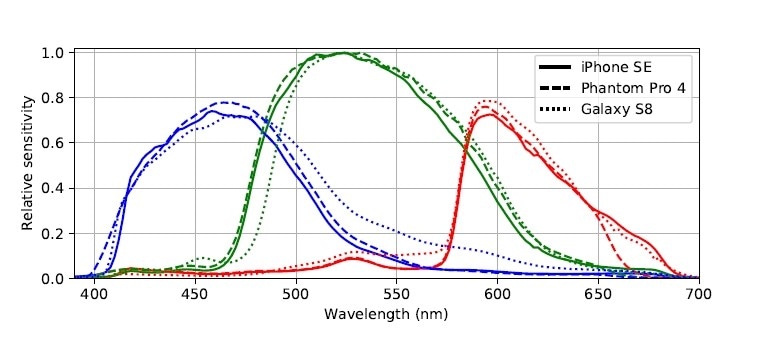Jun 25 2019
Many consumer cameras, including smartphones, are increasingly being utilized for scientific applications, but the fact is, it is not easy to compare and integrate data from numerous devices.
 A new calibration method makes it easier to compare and combine data from different cell phone devices used for scientific applications. The researchers found that while most cameras had very similar spectral response curves there were some differences that could influence how the cameras senses and reproduce colors, even when imaging the exact same scene. (Image credit: Olivier Burggraaff)
A new calibration method makes it easier to compare and combine data from different cell phone devices used for scientific applications. The researchers found that while most cameras had very similar spectral response curves there were some differences that could influence how the cameras senses and reproduce colors, even when imaging the exact same scene. (Image credit: Olivier Burggraaff)
Now, through a novel user-friendly standardized technique, almost all individuals can calibrate these cameras without the need for any dedicated equipment, thus aiding professional scientists, science students, and amateurs to obtain valuable data using any kind of consumer camera.
The low cost of consumer cameras makes them ideal for projects involving large-scale deployment, autonomous monitoring or citizen science. Our standardized calibration method will make it easier for anyone to use a consumer camera to do things like measure pollution by detecting aerosol particles in the air.
Olivier Burggraaff, PhD Candidate, Leiden University
Burggraaff headed the research group from Leiden University based in the Netherlands; he also devised the calibration technique.
In Optics Express, the Optical Society (OSA) journal, the multi-institutional team of scientists reported their latest standardized calibration technique and database, known as Standardized Photographic Equipment Calibration Technique And CataLoguE, or SPECTACLE for short. This database can be utilized for digital single-lens reflex cameras, smartphones, and even cameras aboard drones. Through this database, users can upload calibration data from their respective cameras, allowing other individuals to use.
“SPECTACLE includes many do-it-yourself (DIY) methods, which we found provided results comparable to professional methods that require high-end laboratory equipment,” Burggraaff stated.
Improving citizen science
The standardized calibration technique was mainly developed in response to a demand that emerged as Burggraaff and his colleagues at Leiden University were devising citizen science techniques. The idea was to apply these techniques to determine the optical water quality with the help of a smartphone add-on known as Spectropolarimeter for Planetary Exploration (iSPEX), which was originally developed by them to determine air pollution. This add-on enables a smartphone camera to determine additional optical information like polarimetric and hyperspectral data.
Both iSPEX and SPECTACLE are part of Multiscale Observation Networks for Optical monitoring of Coastal waters, Lakes and Estuaries (MONOCLE)—a project funded by the European Commission and aimed at developing sustainable solutions to determine optical water quality.
To use smartphone cameras to measure water quality we need to understand them well because each manufacturer and each device has its own characteristics. SPECTACLE brings together many existing calibration methods and applies them for the first time to consumer cameras, which will make it much easier for other developers and for us to use these cameras for scientific purposes.
Olivier Burggraaff, PhD Candidate, Leiden University
While calibration techniques meant for consumer cameras have been developed before, such efforts were usually impeded by a lack of available data about the devices or a lack of access to the software. For instance, to date, data cannot be accessed directly from the camera sensor—referred to as the so-called RAW data—or to regulate a number of camera settings like exposure or focus. Nevertheless, the latest versions of Android and iOS enable both.
“As part of SPECTACLE, we are developing a framework for both operating systems to make measurements using RAW data and process these on the phone, which simply was not possible a few years ago,” stated Burggraaff.
DIY versus laboratory methods
In order to test the latest calibration techniques, the investigators compared them with the established techniques using a number of cameras. For instance, they discovered that the DIY technique for determining the way the lens spreads light on the sensor—called flat fielding—corresponded within 5% of results from the usual technique that needs an integrating sphere in a lab setup. In the DIY technique, a paper is taped on the camera and then images of a computer screen or the sun are obtained.
In addition, the researchers tested the spectral response curves of a smartphone camera with the fixed iSPEX and successfully obtained results within 4% of the professional measurement technique, which needs a difficult-to-operate and costly monochromator. It will take half a day if a monochromator is used to calibrate a single camera; however, in the DIY approach, users merely need to take an image of a piece of printer paper in the sun.
We tested a number of cameras and found interesting differences and similarities between them. For example, the cameras’ responses to different wavelengths of light, known as spectral response curves, were very similar among most cameras except for a few devices that showed differences that could influence how the cameras sense and reproduce colors, even when imaging the exact same scene.
Olivier Burggraaff, PhD Candidate, Leiden University
The researchers are planning to apply the SPECTACLE method to a relatively larger number of cameras so that they can fill in the database and obtain a better idea of the properties of cameras. This task will be carried out by the team and also by individuals who wish to upload their calibration data inside the database.
The researchers are also progressing to develop the iSPEX smartphone add-on to enhance its potential to obtain the measurements of air and water pollution. This will involve developing its physical design as well as the algorithms for recovering scientific results from its data, and then simultaneously applying the database and SPECTACLE methods to integrate data from various smartphones.